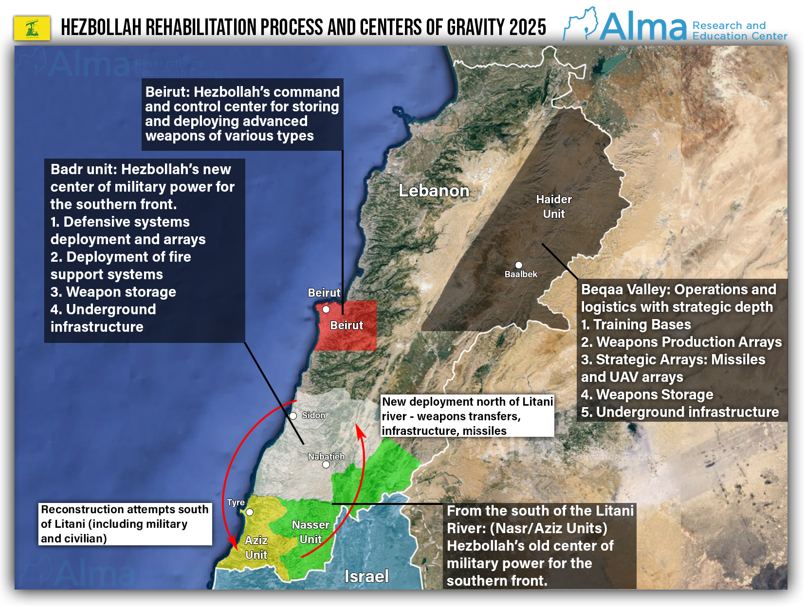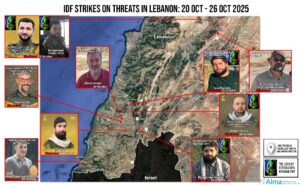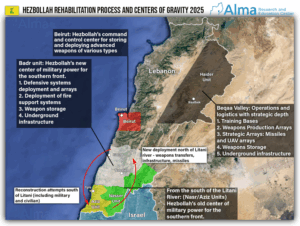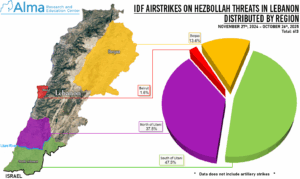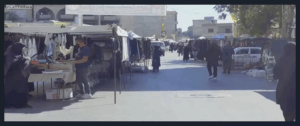Executive summary:
Hezbollah, with Iranian support and sponsorship, is carrying out fundamental and focused military rehabilitation efforts. Iran is actively involved in training, professional accompaniment, and the transfer of experts — which gives the rehabilitation a strategic and deep character.
The organization’s geographic center of gravity on the southern front has shifted north of the Litani — to the Badr Unit sector.
Hezbollah is accelerating processes related to the core of its rehabilitation: indigenous production and repair of weapons (mass production capability for simple weapons and specific capability for advanced/precision weapons), arms and cash smuggling (despite the difficulty of transit through Syria and, as a result, the creation of alternative smuggling routes — “the new corridor”) including also extensive money-changing activity for transferring money—a central axis in financing, recruitment and training, the refreshing of operational plans, offensive readiness, and civilian infrastructures that serve as the base and cover for military rehabilitation. When examining the targeted objectives and the profile of the eliminated population, one can see that they correspond with the components of the rehabilitation core.
In light of its large infrastructure in southern Lebanon that was destroyed, we assess that Hezbollah places emphasis on secrecy.
We assess that there still exists a large remaining infrastructure of the “tunnel country”: tactical (regional) tunnels and underground infrastructure and strategic tunnels that were not damaged, with emphasis on areas where no Israeli ground manoeuvre was conducted — south of the Litani, north of the Litani up to Sidon (the Badr Unit area), and in the Bekaa, which is Hezbollah’s logistical-operational hinterland. In the tunnels and underground infrastructure in these areas, we estimate there are large quantities of weapons, some for storage and some prepared for launching.
Hezbollah is advancing an intensification of its UAV and loitering-munition array as a central effort for the future confrontation.
Hezbollah retains operational strike capability in various formats; as of today, it does not have broad invasion capability into the Galilee. it is not facing an actual dismantling of its weapons.
The State of Lebanon and the Lebanese Armed Forces are limited in their ability and willingness to enforce weapons disarmament, among other reasons due to demographic issues, internal cooperation, fear of confrontation, and accessibility constraints. The gap between publications about (alleged) weapons-disarmament actions and reality are very large.
Internal political events in Lebanon (for example, the Raouché rock crisis in September 2025, the municipal elections that took place in May 2025, and the parliamentary elections expected in May 2026) constitute a significant perceptual incentive for Hezbollah and militants in efforts to avoid weapons dismantlement.
Military and civilian rehabilitation are intertwined: civilian — economic infrastructures serve as the basis for military rehabilitation. The aim of Israeli strikes in Lebanon is to damage this rehabilitation composite. Lebanon does not have the right to rehabilitate civilian infrastructure as long as it serves as cover and a base for Hezbollah’s military rehabilitation. Israel’s interest is to weaken this infrastructure as long as it continues to serve as a base and cover for Hezbollah’s military rehabilitation.
The purpose of strikes against ostensibly “civilian” infrastructures and “civilian professionals” is in fact to frustrate Hezbollah’s attempt to carry out military rehabilitation while “hiding” under the cover of civilian reconstruction.
The Lebanese, Arab and international media attempt to present this as a war against civilian rehabilitation and emphasize that it is a direct strike against civilian teams. It would be preferable for the media — and, more importantly, Lebanon’s leadership — to distinguish clearly between genuine civilian actors and those who merely appear to be civilian…
The repeated return of Lebanese residents to villages along the contact line with Israel poses a significant risk of civilians being used as human shields and also presents potential for Hezbollah’s military rehabilitation close to the border with Israel. At this stage, there is no identified permanent, continuous and significant Hezbollah presence and activity on the contact line.
===========================================================
From ongoing and close monitoring of developments in Lebanon, it can be assessed to what extent Hezbollah, under Iranian sponsorship and assistance, is acting toward military rehabilitation (smuggling and procuring weapons and funds, repairing and producing weapons, recruiting and training operatives, rehabilitating military infrastructure, refreshing operational plans, restoring offensive capability, and more).
Hezbollah is accelerating its rehabilitation particularly in the area north of the Litani, in its new geographic center of gravity — the Badr Unit sector — which has become the focal point of Hezbollah’s deployment in the southern front in terms of fire activation, defence, and weapons storage. Before the war, the center of gravity was south of the Litani in the Naser and Aziz units’ sectors. As a result of the war, and due to severe damage to those units, the center of gravity shifted north of the Litani — to the Badr Unit sector.
The Bekaa region remains Hezbollah’s strategic depth, both operationally and logistically. Among other things, the Bekaa hosts training, weapons production, and storage infrastructure, and includes sites of strategic arrays: missiles and loitering munitions (some of which, we assess, are located in significant undamaged underground facilities).
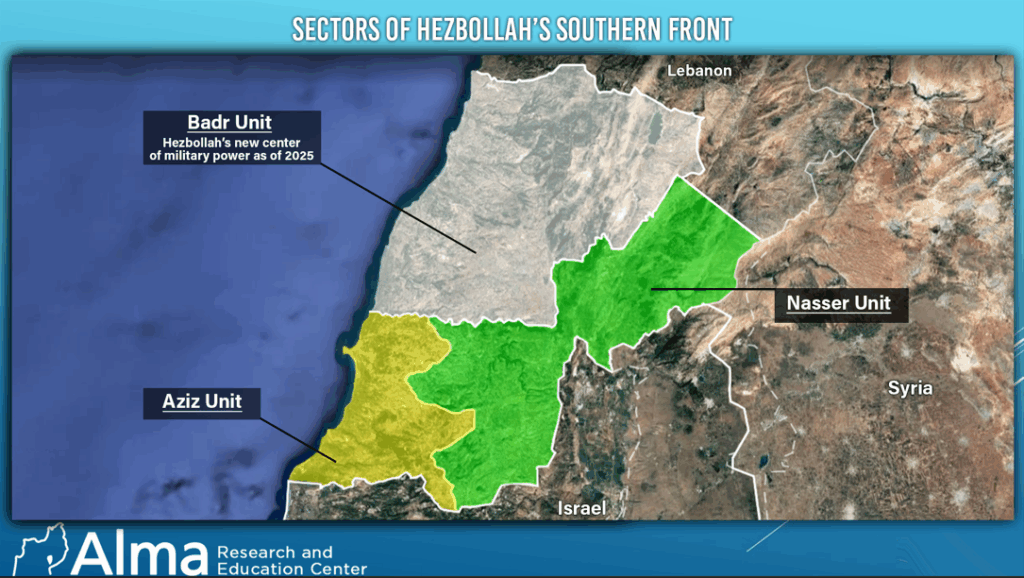
Hezbollah’s rehabilitation efforts focus on survivability and transitioning to more covert operations, maintaining, repairing, and producing weapons, smuggling, organizational processes, refreshing military operational plans, and conducting training and exercises.
The new smuggling corridor:
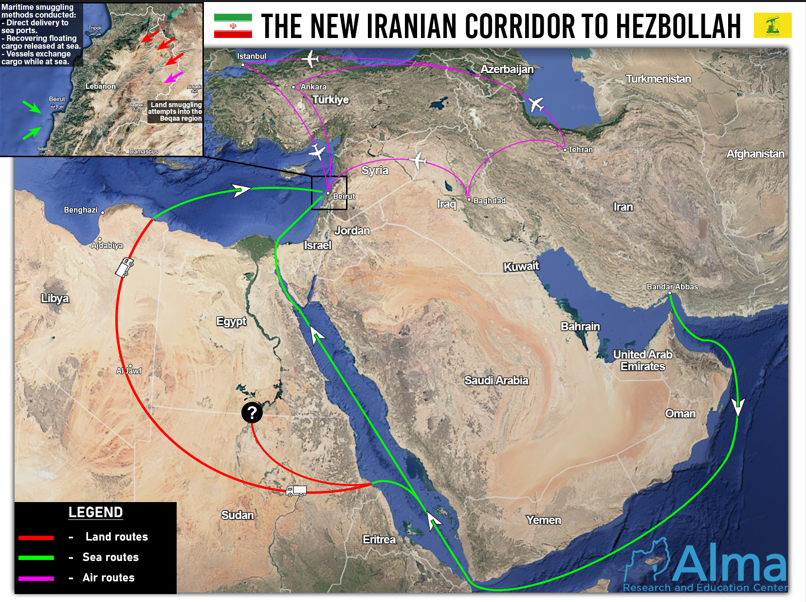
It should be noted that despite the collapse of the land corridor through Syria, Hezbollah continues to attempt to smuggle light and medium weapons from Syria to Lebanon every week. The weapons include, among others, dozens and hundreds of advanced anti-tank missiles of the Kornet type and Grad rockets. Some are seized by Syrian security forces. But for every smuggling attempt that is caught, there are several that succeed.
As part of lessons learned from the last war (and from the Russia-Ukraine conflict), Hezbollah is focusing on building and strengthening its UAV and loitering-munitions array and marks it as a central, successful effort for the next confrontation.
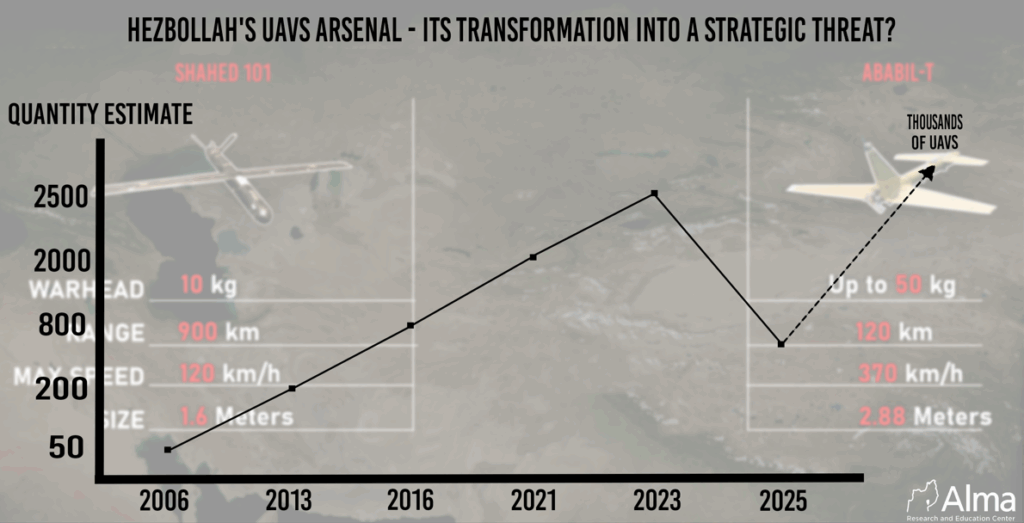
Within its rehabilitation processes, we assess that Hezbollah is moving from a concept of tens of thousands of aboveground and underground infrastructures previously deployed in an organized network south of the Litani (for defensive purposes — against Israeli manoeuvres — and for offensive purposes — “leaping point” infrastructures for penetration into Israeli territory) toward a concept of greater secrecy. This secrecy, in our assessment, is partly based on underground networks deep inside Lebanon that were not damaged.
In addition, it appears that Hezbollah seeks to cultivate and maintain ties with other power actors with potential for activity against Israel, emphasizing those that do not operate under its command, such as the Amal Movement, Hamas, the Palestinian Islamic Jihad (PIJ), Al-Jama’a Al-Islamiyya, and the Syrian Social Nationalist Party.
Hezbollah also continues to operationally manage and cultivate several proxies that report directly to it, such as the Imam Hussein Militia, the Ali Asaf Militia (a missile unit), and the Lebanese Resistance Battalions.
Hezbollah’s interest at present is to preserve, as much as possible, the continuity of its military rehabilitation and to avoid actions against Israel that could cause further significant damage to its rehabilitation processes, beyond the current damage inflicted by Israel. As part of this interest, Hezbollah also considers the situation and hardships of the Shiite base following the war.
As of this writing, over 610 Israeli strikes have been carried out across Lebanon against Hezbollah’s rehabilitation activities at various levels. The general objective of these strikes is to disrupt rehabilitation, restrict the freedom of movement and action of the organization’s operatives, damage weapons and infrastructure, and create a sense of vulnerability and intrusion.
The emphasis of strikes in southern Lebanon is to disrupt and prevent Hezbollah’s involvement in rehabilitating the front-line area and the contact line with Israel, pushing Hezbollah operatives and capabilities north of the Litani River. Civilian reconstruction serves as the cover and basis for military rehabilitation.
As of October 26, 2025, Israel has carried out 613 strikes in Lebanon during the ceasefire. The distribution of strike areas and their characteristics is as follows:
47.5% of strikes south of the Litani River — an area that before the war contained thousands of Hezbollah fixed infrastructure targets, including underground facilities. These are currently targets that were not addressed during wartime strikes and manoeuvres, and are now subject to repeated strikes on rehabilitation attempts.
37.5% of strikes north of the Litani River (the current operational center of gravity, the Badr Unit sector).
Approximately 13% of strikes in the Bekaa (an operational and logistical strategic depth, hosting, among other things, training facilities, weapons production sites, and strategic arrays such as missiles and loitering munitions — some located underground).
Although the proportion of strikes in Beirut is marginal, this does not mean Hezbollah has no activity in the Beirut area. Beirut has historically been, and remains, a central area that Hezbollah uses for its operational purposes, taking advantage of the urban environment as a human shield. Publications on strikes in the Beirut area indicate that advanced weapons arrays are deployed there.
As a reminder, for example, in March 2025, the Israeli Minister of Defence stated, following IDF strikes in the Dahiya area of Beirut, where Hezbollah infrastructure for weapons and loitering-munitions storage was targeted, that Israel would not allow Hezbollah to build or operate weapon capabilities that threaten Israel.
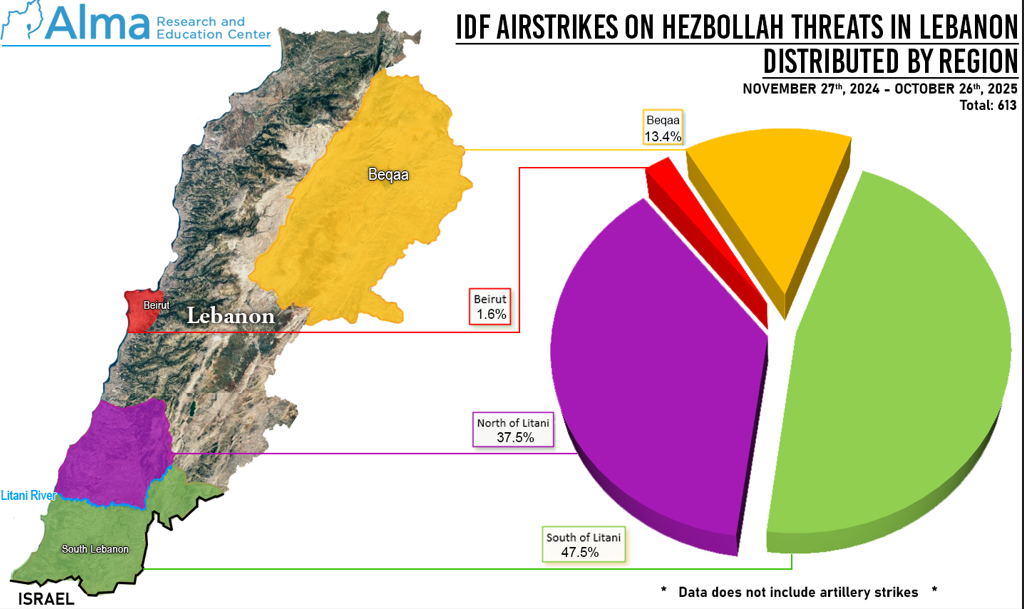
Note — we assess that Hezbollah currently retains about one-third of the firepower it had before the war.
The complexity in the area south of the Litani River is expressed, among other things, by the fact that Hezbollah operatives who are local residents live in the villages in that area. According to our monitoring data of strikes in which Hezbollah operatives in that area were eliminated, it appears that these Hezbollah operatives , belonging to various Hezbollah units and identified as carrying out rehabilitation activity or other activity within the organization, are being targeted.
There is a clear correspondence between the nature of the targeted objectives and the roles of those neutralized in Hezbollah, and the organization’s rehabilitation efforts.
In most of the villages adjacent to the border, 90–100% of residents were reported to have evacuated during the war. We assess that this evacuation rate remains in effect today and that there is currently no continuous, permanent, or significant Hezbollah presence in these villages in general, and no significant rehabilitation activity in particular.
Recent publications in Israel claiming Hezbollah’s return to the contact line are inaccurate. It is clear to us that Hezbollah operatives exploit civilian cover for their operational needs and may approach the border, but their presence, if it exists, is brief, sparse, and temporary only.
The villages along the contact line served before the war as a large Hezbollah military infrastructure, whose purpose included serving as a platform for the planned attack and invasion into the Galilee. IDF air strikes and the IDF ground manoeuvre during the war focused on these villages and today most of them are destroyed.
A permanent return of displaced residents to the contact-line area with Israel must not be allowed. Such a return would again enable Hezbollah to use residents as human shields for the military infrastructure Hezbollah wishes to rehabilitate near the Israeli border.
That said, let us not be mistaken. Hezbollah has operational capability today, and given a decision, can carry out offensive activity against Israel in various modalities, with emphasis on focused attacks. Beyond that, at any given moment a rogue independent action by Hezbollah operatives is possible, arising from a different worldview and/or disagreements about the organization’s overall direction.
Those who think Hezbollah will be dismantled / disarmed are wrong and misleading. Those who think Israeli strikes give Hezbollah an “excuse” not to disarm are doubly wrong and misleading. They will take Hezbollah’s soul before they take its weapons…
The Raouché rock crisis (25 September 2025) is a milestone in the narrative surrounding Hezbollah’s rehabilitation. The crisis demonstrates Hezbollah’s determination to continue to entrench itself at the center of Lebanon’s political and public stage, even at the price of clashing with the government. It is a perceptual victory for Hezbollah, which presents itself as unbowed by pressure and continues to set the agenda. The perceptual victory at Raouché Rock constitutes an important milestone for Hezbollah both toward its Shiite base and toward the government in the context of the “disarmament” program — i.e., matters will happen as Hezbollah wishes, and in the context of disarmament, when Hezbollah does not want it, it will not happen.
It is no coincidence that Hezbollah is investing significant efforts in its preparations for the northern parliamentary elections in May 2026. Hezbollah understands very well that success in these elections (following its ability to maintain its strength in the municipal elections held in May 2025) would constitute a significant and critical perceptual incentive for its central position in Lebanon.
Hezbollah is not alone. The Iranians have made a strategic decision to rehabilitate Hezbollah militarily. Iran is deeply involved in Hezbollah’s rehabilitation processes. Professional officers and experts from the Revolutionary Guards in general, and the Quds Force in particular, who serve as knowledge hubs in various fields are physically present in Lebanon and are closely mentoring and guiding Hezbollah.
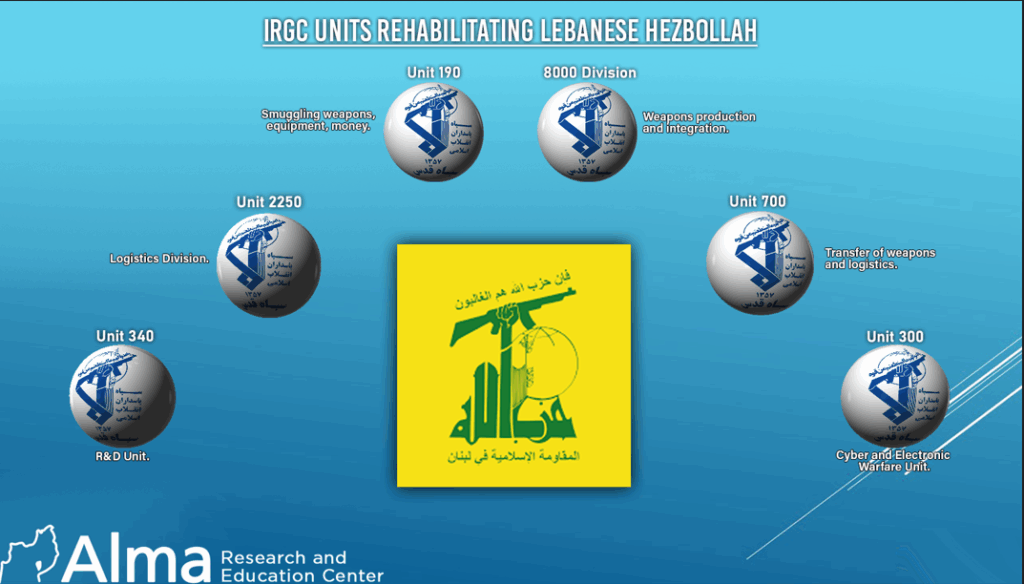
The State of Lebanon neither has the will nor the capability to truly confront Hezbollah. Lebanon’s main force for “weapons disarmament,” the Lebanese Armed Forces (LAF), is very limited in its operations and is neither willing nor able to confront Hezbollah for the following reasons:
- Demographics (approximately 45% of LAF soldiers are Shiite; some estimates place this at around 60%).
- Inherent fear of civil war.
- Movement and operational restrictions (the LAF operates in the disarmament context only south of the Litani River and is very limited in its movement; it cannot enter Hezbollah military areas unless authorized by Hezbollah).
When and if disarmament activity does occur (most of which is directed by the IDF via the joint operations center), it can be characterized by three outcome features:
- Lebanese Army handles only weapons already targeted and rendered unusable by the IDF, essentially only removing the remnants.
- “Revolving door” coordination — if a certain weapon is taken and Hezbollah wants it back; the Lebanese Army returns it to Hezbollah.
- Coordination on what remains in army stockpiles — a small portion of weapons (intentionally relinquished by Hezbollah) remains in Lebanese Army depots.
According to a report on Sky News Arabia (sourced from an Israeli briefing) on 24 October 2025, since the ceasefire on 27 November 2024, Israel submitted 1,734 complaints regarding Hezbollah violations to the joint operations center supervising the ceasefire. The LAF was required to address 840 complaints. In practice, the LAF addressed 528 of them. Israel independently addressed 812 of these complaints. In addition, the LAF on its own initiative addressed 452 Hezbollah violations without being required to do so by the joint operations center.
Do not let these figures confuse you. The standard of LAF handling follows the three features outlined above.
The civilian-rehabilitation axis enables military rehabilitation and must also be addressed, particularly in southern Lebanon.
It is possible that Hezbollah is preparing for a new phase of civilian reconstruction in areas damaged by recent Israeli strikes and is advancing logistical and organizational preparations to launch large-scale projects in southern Lebanon.
Civilian infrastructure enables military rehabilitation and activity. Therefore, the strikes are also directed at ostensibly “civilian” targets. These targets are “civilian” only in appearance and in fact serve Hezbollah’s military rehabilitation effort.
Over the past months, and especially recently, the strikes have focused on engineering equipment (since the start of the ceasefire, more than 20 sites with tractors, excavators, and the like have been struck), concrete and asphalt production sites, fuel depots, and “civilian” operatives of the Jihad al-Binaa organization and the engineering companies working on its behalf, as well as activity of the “Help One Another” association and “Green Without Borders.” Regional liaison officials (Rabat) are also targeted because of their important role as connecting nodes in reconstruction contexts — between Hezbollah’s operational needs and desires and the local population.
“Civilian” commercial activity in Hezbollah-controlled areas is part of its economic-logistical fabric and greatly assists its military rehabilitation process.
The focus on disrupting rehabilitation should continue by striking relevant civilian infrastructure , acting against logistical capabilities, sites producing engineering infrastructure, solar electricity systems, and economic assistance frameworks that serve as cover for Hezbollah’s rehabilitation activity ,as well as civilian professionals working on Hezbollah’s behalf, Hezbollah operatives involved in this rehabilitation, and associations operating for Hezbollah.
Below are several central examples of such strikes:
- On 03 September, a strike was carried out in the industrial area of Kfar Anzar (Nabatiyeh district). As a result, concrete production sites, cement-bricks and asphalt production sites were damaged, and engineering equipment was also struck.
- On 11 October, a significant strike was carried out in the Al-Masilaḥ area (Sidon–al-Zahrani district). The struck site belonged to the company شركة طباجة للمعدات ش.م.ل (Tabaja Equipment Co. Ltd.), and according to reports contained several engineering machines: bulldozers, rollers, trucks and cranes, which were completely destroyed.
The Tabaja family is a well-known Shiite family in southern Lebanon, particularly in the Nabatiyeh area and surrounding villages. The family member best known to us is Adham Hussein Tabaja, born 1967, who was designated by the U.S. Treasury as a supporter of terrorism on 15 June 2015 (Specially Designated Global Terrorist, SDGT) and is under sanctions. Adham Tabaja is a senior Lebanese businessman associated with Hezbollah and was identified as one of the key figures in the organization’s financing network. His companies are engaged in construction, management, and maintenance of real-estate assets. His brother, Hassan Tabaja, also appears on sanctions lists as someone who operates on his behalf and in business cooperation with Hezbollah.
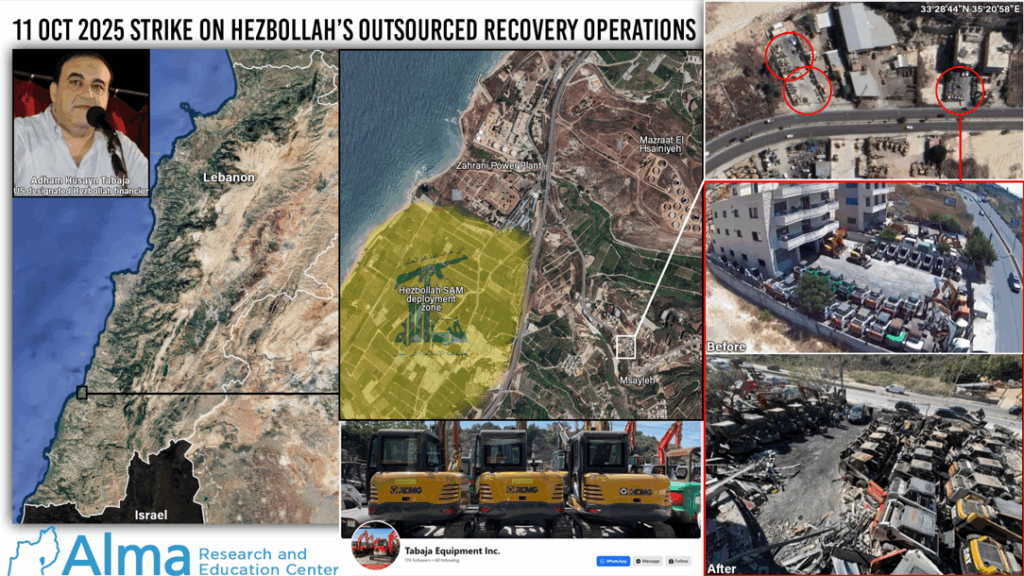
After the strike, “Tabaja Equipment Co. Ltd.” published a statement stressing that it is a private company operating independently and not affiliated with any political, party, or military organization, and that the attack was an unlawful strike on a civilian site. The company also denied any connection to Adham Tabaja.
However, considering the foregoing, it does not appear difficult to link the company to Hezbollah’s rehabilitation activities.
On 16 October, a strike was carried out in the Anzar – Mazraat Sinai area (Nabatiyeh district). A quarry and facilities of the company “Al-Majabel” for concrete production were targeted. In addition, a fuel depot containing half a million liters of diesel was struck.
The quarry produces concrete that Hezbollah uses to rehabilitate its military infrastructure, which had already been targeted in the past.
Damage to solar panels: The widespread use of solar panels as “green energy” in Lebanon is not driven by environmental awareness but by necessity, as the state electricity infrastructure is collapsing and non-functional. Hezbollah’s military infrastructure consumes large amounts of electricity and requires continuous power supply. Hezbollah has established and deployed a very large network of solar panels for its military infrastructure.
The solar panels used by Hezbollah are a target. To date, hundreds of thousands of solar panels in Lebanon have been damaged due to their direct connection to Hezbollah’s operational activity during the war and to Hezbollah’s rehabilitation efforts during the ceasefire.
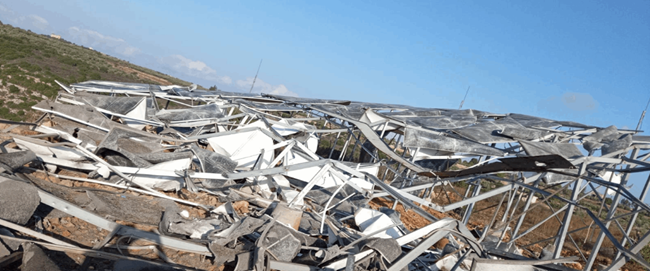
In addition to striking relevant civilian infrastructure that enables Hezbollah’s rehabilitation, there are several examples of targeting “civilian” professionals, Hezbollah operatives directly involved in rehabilitation, and relevant associations:
On 02 October, two Hezbollah operatives, Ahmad Saad and Mustapha Rizk, were eliminated. They worked as engineers for the engineering and development company “Maamar.” As previously reported, civilian engineering companies such as “Maamar” operate under Jihad al-Binaa’ (Construction Jihad) and serve as Hezbollah proxies, also responsible for building Hezbollah’s military infrastructure under the cover of civilian reconstruction. Jihad al-Binaa’ operates under Hezbollah’s social unit within the Executive Council and is responsible for rehabilitating buildings and infrastructure.
During September and October 2025, four Hezbollah “rabat” (regional liaison official) were eliminated. The eliminated were, Abd al-Munem Musa Sweidan, Rabat of the village of Yatir, Ali Muhammad Qurani and Mahmoud Ali Issa, Rabat’s of Kafra and the Rabat of Marhab al-Biad’a area Abd Mahmoud Al-Sai’d.
The “Rabat” — the “regional liaison official” — is responsible for connecting the local population with Hezbollah, including property acquisition for the organization, distributing aid, managing land, and social matters, all also in the context of “civilian” rehabilitation processes.
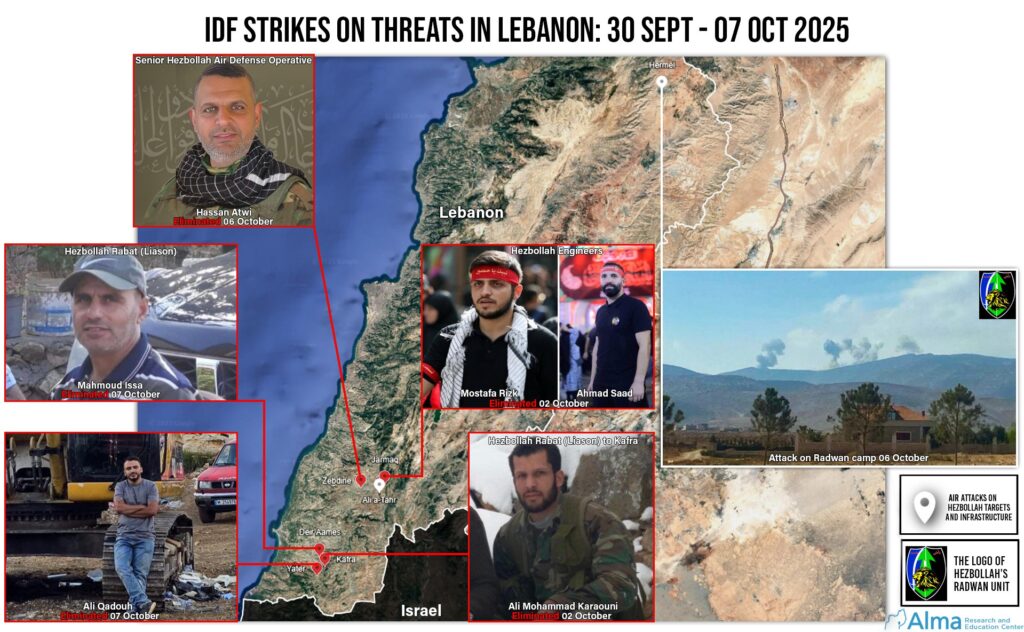
The “Wataawanou” Association (Arabic: جمعية “وتعاونوا” الخيرية | English: Wataawanou Association Charity) ***קישור למאמר מאפריל 2025** is another arm of Hezbollah’s economic-logistical network. It operates within civilian reconstruction, including to support military rehabilitation objectives.
The association generates social and economic influence and dependency among the population in Lebanon (not only the Shiite population), which allows Hezbollah to operate freely within its area of influence, both in civilian aspects and in terrorist-military activities.
The campaign to place mobile buildings across southern Lebanon during the ceasefire, conducted by the “Wataawanou” Association, also aims to embed and conceal Hezbollah’s military activity and intelligence collection in southern Lebanon and along the contact line. It is no coincidence that some of these mobile buildings were targeted in recent months.
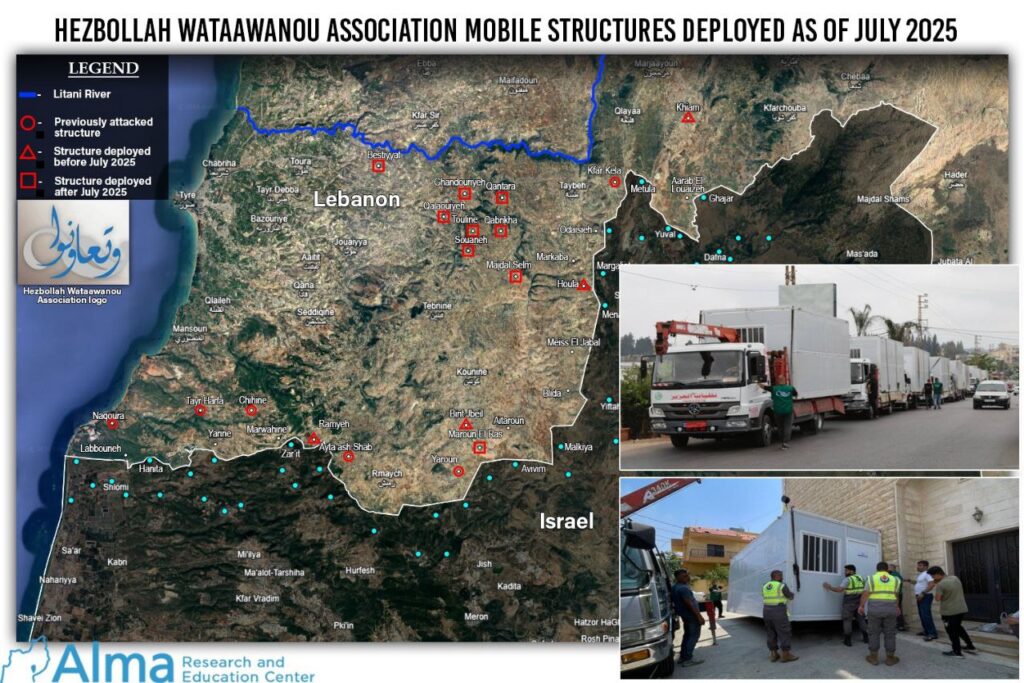
Is Lebanon, under external pressure, beginning to distinguish between genuinely civilian actors and those that merely appear so, and to act against the latter?
Recently, Whish Money, a private Lebanese company specializing in money transfer services, digital payments, and alternative financial solutions , operating in Lebanon as a substitute for the traditional banking system, closed the account of the “Wataawanou” Association. According to a report in Al-Sharq Al-Awsat, this is another step in a government policy to tighten financial oversight of money transfer companies and associations, as part of Lebanon’s efforts to comply with the Financial Action Task Force (FATF) requirements for combating money laundering and terrorist financing. These measures are claimed to demonstrate Lebanon’s seriousness to the international community, but in practice they complicate operations for Hezbollah and the network of economic organizations operating under its sponsorship, particularly in the areas of rehabilitation in the south and Beirut suburbs.
Although Whish Money presents a neutral, commercial image, media outlets in Lebanon note that Hezbollah and the associations linked to it (such as “Wataawanou”) have used its services to transfer funds to southern Lebanon.
Summary
Hezbollah, under the direct sponsorship and assistance of Iran, is managing a broad military and civilian rehabilitation process in Lebanon, aimed at restoring its capabilities after the severe damage it suffered during the last war. The organizational center of gravity has shifted to the area north of the Litani River. Rehabilitation efforts focus on weapons and funds smuggling, repair and production of arms, recruitment and training, alongside changes and updates to operational doctrines. Iran actively contributes through advising, training, and leading the process, which constitutes a key element of its regional strategy.
Since the ceasefire came into effect, Israel has carried out hundreds of strikes against both military and ostensibly civilian infrastructure. The targeted civilian infrastructure de facto, serves as a base and cover for Hezbollah’s military rehabilitation. The State of Lebanon and the Lebanese Armed Forces are very limited in their ability to confront the organization.
The right to rehabilitate Lebanese civilian infrastructure does not exist as long as it serves as cover and a base for Hezbollah’s military rehabilitation.
Under these circumstances, Hezbollah continues to maintain its political position, operational capabilities, and grip on the Shiite community, viewing both military and civilian rehabilitation as essential for sustaining its influence in Lebanon and in any future confrontation with Israel.

